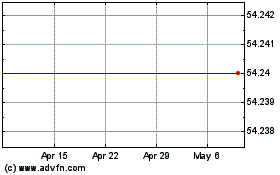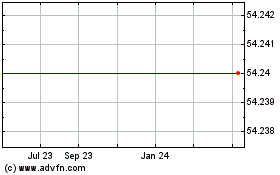Deal Volume Heats Up Among Midsize Banks
August 18 2015 - 7:47PM
Dow Jones News
By Rachel Louise Ensign
The biggest U.S. banks have been locked out of the recent merger
boom, but smaller banks are starting to go shopping.
Through Tuesday, U.S. banks have announced $24.3 billion in
mergers this year, according to data provider Dealogic. That is up
63% from the pace a year ago and is also the highest figure for
this point of the year since 2009.
The sector's deal activity got its latest boost Monday night
when BB&T Corp. said it was buying National Penn Bancshares
Inc. for $1.8 billion in cash and stock. The announced deal was
BB&T's third in less than a year.
Kelly King, chief executive of Winton-Salem, N.C.-based
BB&T, said the bank is doing deals to grow in an environment in
which low interest rates have weighed on profits. For a bank to
successfully navigate these hurdles "the only answer is scale," Mr.
King said.
In other words, BB&T aims to boost revenue through the deal
over time without significantly adding to costs that generally keep
bank CEOs up at night, such as regulatory compliance costs to
technology and cybersecurity budgets.
Deal making has been challenging for banks since the financial
crisis largely because regulators are giving greater scrutiny to
the largest banks. But midsize regional lenders are finally gaining
confidence because some deals have been approved, including CIT
Group Inc.'s $3.4 billion purchase of the parent company of OneWest
Bank NA, approved in July.
Investment bankers broadly specializing in financial companies
are optimistic about the pickup in deals.
"It's very active, and we expect there to be more," said Thomas
Michaud, president and chief executive of Keefe, Bruyette &
Woods, an investment bank specializing in financial services.
"You're starting to see more of the bigger banks show up as
buyers."
Still, one high-profile regional bank deal--M&T Bank Corp.'s
announced purchase of Hudson City Bancorp Inc.--has gotten stuck
because of regulatory concerns, discouraging more activity.
Mr. King said BB&T is now likely to take a break from buying
other banks for at least six months because it wants to focus on
closing the National Penn purchase and integrating its purchases of
Bank of Kentucky Financial Corp. and Susquehanna Bancshares Inc.,
both of which closed this summer.
BB&T's purchase of Allentown, Pa.-based National Penn brings
the number of total bank deals announced so far this year to 219,
which remains below 250 figure for the same period in 2014 despite
the higher total volume.
Mr. King said National Penn's sale is an example of an
institution seeking a deal as a way of grappling with costly new
regulations that kick in when they hit a certain size, a trend
experts expect to continue. Representatives of National Penn didn't
return calls for comment.
National Penn, with $9.6 billion in assets, was right under the
$10 billion threshold at which banks must start conducting annual
stress tests under the 2010 Dodd-Frank financial law.
"They were hovering at $9.6 [billion] ... They knew they had to
go over a lot or not go over at all" in order to not be overwhelmed
by new compliance costs, Mr. King said.
"The economics of selling just overwhelm [those of] staying put"
and risking that the banks asset would go over the mark slightly,
he added.
Deals are cropping up around a number of these thresholds set by
Dodd-Frank, said Mr. Michaud.
"You have these size thresholds at $10 billion and $50 billion
where management teams and boards of directors have to figure out
which way they're going to go," he said. "They're between the
options of a sale and growing organically." Banks with $50 billion
or more in assets are considered "systemically important" by bank
regulators and are subject to more rigorous Federal Reserve stress
testing process.
The biggest bank deal of 2014 was driven by similar concerns:
CIT's purchase of the parent company of OneWest Bank was motivated
by CIT's desire to do a deal could would allow it to jump over the
$50 billion asset level by enough that it would have sufficient
revenue to cover the added compliance costs.
"If we had grown to just $52 billion we would be in the worst
spot," said CIT Chief Executive John Thain last year. "We'd have
had all the expense of going over $50 billion but only $2 billion
more of assets to cover the expense base."
For instance, Zions Bancorp spent $20 million preparing for the
2015 round of Federal Reserve stress tests. That would represent
about 1.25% of the $1.6 billion in noninterest expenses that the
bank has said it would like to stay below in 2015 and 2016.
Even BB&T, which estimates it will have about $220 billion
in assets after the National Penn deal closes, says it now has to
keep an eye on a different regulatory threshold in future deals:
$250 billion in assets. Banks beyond this threshold are subject to
complex additional requirements under the law.
"You wouldn't just want to go from $249 [billion] to $251
[billion]," Mr. King said. "All of a sudden you turn into a pumpkin
when you hit 251 and you don't have the scale to manage it."
Subscribe to WSJ: http://online.wsj.com?mod=djnwires
(END) Dow Jones Newswires
August 18, 2015 19:32 ET (23:32 GMT)
Copyright (c) 2015 Dow Jones & Company, Inc.
BB and T (NYSE:BBT)
Historical Stock Chart
From Aug 2024 to Sep 2024

BB and T (NYSE:BBT)
Historical Stock Chart
From Sep 2023 to Sep 2024
